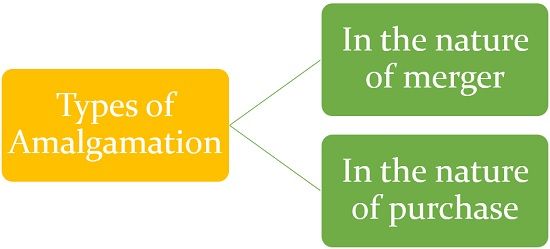Definition: Amalgamation, as the name itself suggest, is a form of external reconstruction, in which there is a combination of two or more than two companies, either by merger or by takeover. It indicates two activities:
- Two or more entities fuse to form a new company, wherein the individual identity of the two entities vanishes and the company so formed comes into being. For example, Alpha Ltd. and Beta Ltd. merge to form Alpha-Beta Ltd.
- Absorption of one company, by another. In this case, usually, a smaller company fuses into a larger one and thereby loses its existence. For example, Alpha Ltd. takes over the business of Beta Ltd.
In amalgamation, the companies that are wound up or merged are termed as vendor or transferor companies. On the other hand, the new company that acquires the liquidated ones or the company with which the vendor company is combined is considered as the transferee or vendee company.
Purpose of Amalgamation
Companies go for amalgamation, for a number of reasons such as:
- Gaining synergy
- Avoiding competition
- Increasing efficiency
- Business expansion
- Reaping economies of large-scale production
When amalgamation is affected, some or all the assets and liabilities of the vendor companies, are transferred to the vendee company. Similarly, the shareholders of the old entity turn out as the shareholders of the amalgamated entity.
Purchase Consideration
Purchase Consideration refers to the price paid by the vendee company to the vendor company, is called purchase consideration. It is the total of shares, debentures, etc. issued and the payment made in cash or kind. Direct payments made by the transferee company to the creditors or debenture holders will not be taken into account while calculating the purchase consideration. Those liabilities which are not taken over by the vendee company has to be met by the vendor company.
Types of Amalgamation
As per Accounting Standard 14, there can be two types of amalgamation:
- Amalgamation in the nature of merger: When the assets and liabilities of the companies are genuinely pooled, as well as the interest of the companies and shareholders, is also combined, then it is called an amalgamation in the nature of merger.
- Amalgamation in the nature of purchase: When the assets and liabilities of the company are acquired by another and purchase consideration is paid by the transferee company.
When it comes to the method of accounting, if the amalgamation affected is in the nature of merger, then pooling of interest method is followed, whereas if the amalgamation is in the nature of the purchase, in that case, purchase method is followed.


Leave a Reply